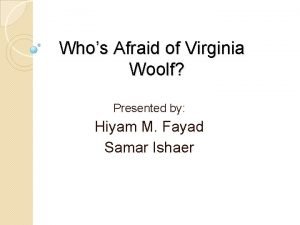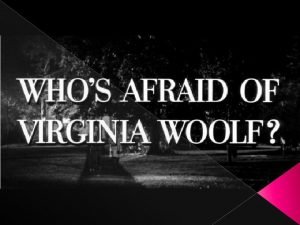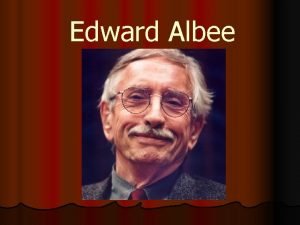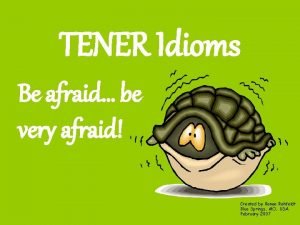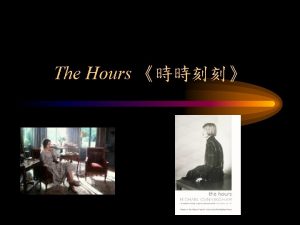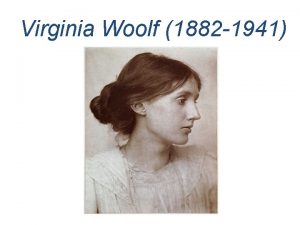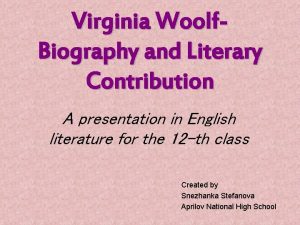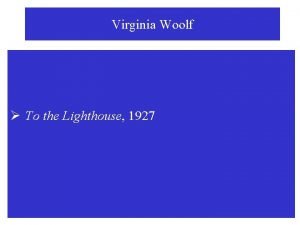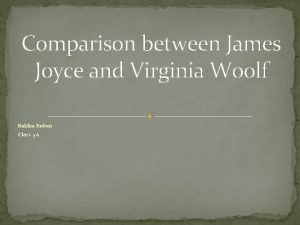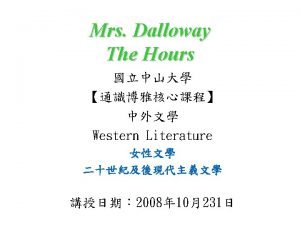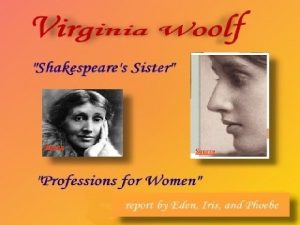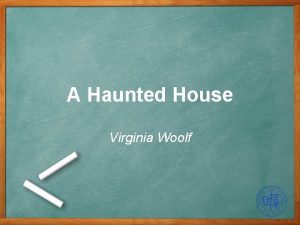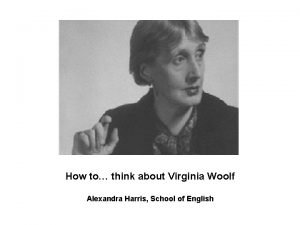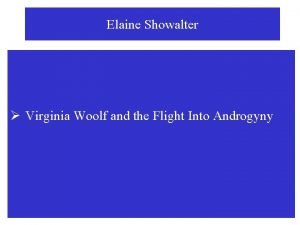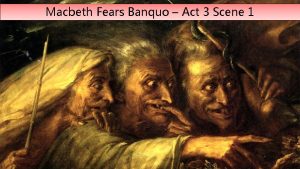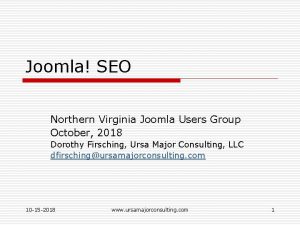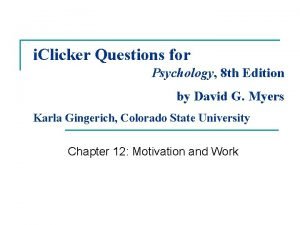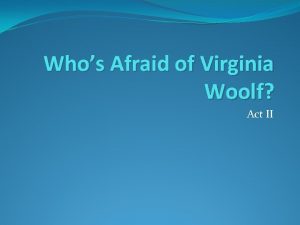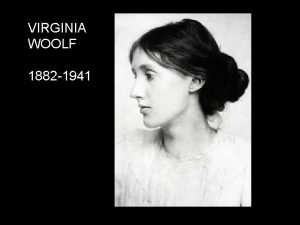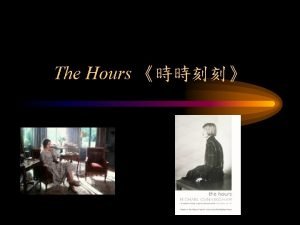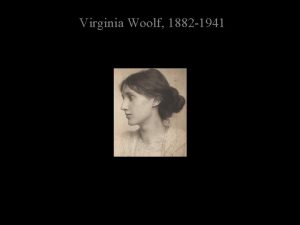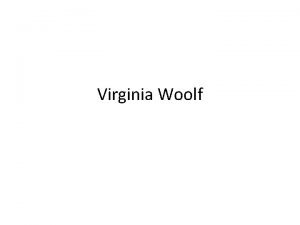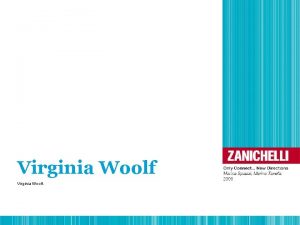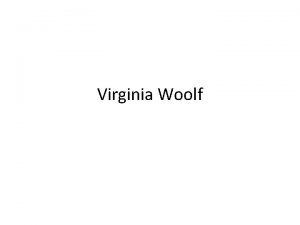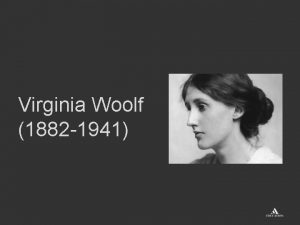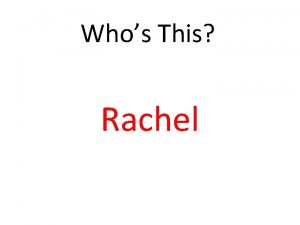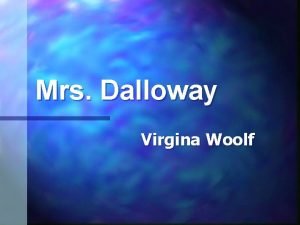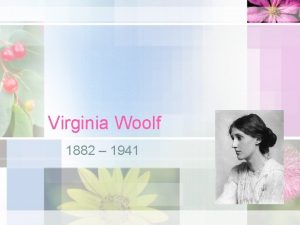Whos Afraid of Virginia Woolf Act III Act




















- Slides: 20

Who’s Afraid of Virginia Woolf? Act III

Act III, Scene I Martha: a woman full of desperation and self- pity. We see her starved for affection. Martha’s ‘worship’ of her father has turned into admitting he cries all the time.

Martha and George cry all the time too…alcohol metaphor signifies the painful cycle of their lives.

Act III, Scene II Nick is a ‘flop’ in bed as we are told here. Martha’s vulnerability…Nick’s sexual inadequacies. We are beginning to see the truth behind the act.

Martha & Nick Martha calling the men she’s been with ‘poor babies’. Could they be a substitute for children themselves. Martha’s suggestion to Nick that George is the only man that has satisfied her again evokes appearance and reality.

George & Martha: George ‘who has made…the mistake of loving me and must be punished for it. ’ Does Martha see herself as unworthy of love and therefore despises anyone who would love her. She sums the relationship up as: ‘George and Martha: sad, sad. ’

Martha & Nick as a ‘gelding’ or castrated horse. Does this mean that Martha has destroyed Nick as well as George? Why does Nick readily take on the role of houseboy? Is he desperate to get ahead? Or because Honey is still laid out in the bathroom. The term Gigolo is a male prostitute. Could Nick be called one?

Act III, Scene III George shouting flowers for the dead. This heralds the death of their son. George & Martha attack Nick. ‘Pansies! Rosemary! Violence!’ again the violence references come out.

Truth & Illusion The scene is littered with references to truth and illusion and Martha even makes theme explicit here.

George He was once the evenings ‘slave’ and now he has become the ‘master’. George warns Martha that he will win.

Religious Allusion Easter Sunday: the celebration of a resurrection; however George is planning a death.

ACT III, SCENE IV Martha’s beautiful description of the child’s childhood is very poetic and a million miles from her crass side. As this occurs, George recites a Catholic mass.

Honey’s change ‘I want a child’ – this suggests a change in the character o Honey in the play.

The Son George & Martha once again blame each other for his problems. The circumstances of his death mirror the ‘bergin’ story. Therefore, the first evidence of it being a myth. Nick soon realises that the whole story was an invention.

The Child as Jesus Some readers see the child as Jesus. He is killed by George to save the sins of mankind (George & Martha). Even the eating of the telegram could be seen as a form of communion.

Infertility George ‘We couldn’t’ – in reference to the fact that they can’t have children.

The reason behind the child Some suggest that Albee uses the child to suggest that we need illusions (the child) in the modern world to avoid madness.

George & Martha Does George kill the child because: 1) He is acting nobly and he wants to save Martha from her destructive fantasy of the child. OR 2) He is punishing Martha for what she has done earlier in the play.

Act III, Scene V All of the plays drunken energy has now subsided and been replaced by an exhausted set of characters. It’s all filled with uncertainty. George sings Martha ‘Who’s Afraid…’ as a lullaby now.

Three Readings of the Play 1) Hopeful: now that they have ‘exercised’ their demons – and their vices & cruelty – they can move on with happier, more honest lives. 2) Bleak: George & Martha are totally defenceless against the world. 3) Ritual: George & Martha are simply completing the circle of horrible events that characterise all their evenings. It’s relatable to absurdist theatre.
 Who's afraid of virginia woolf themes
Who's afraid of virginia woolf themes Who's afraid of virginia woolf as an absurd play
Who's afraid of virginia woolf as an absurd play Who's afraid of virginia woolf themes
Who's afraid of virginia woolf themes Tengo tienes tiene tenemos tenéis tienen
Tengo tienes tiene tenemos tenéis tienen Mrs dalloway summary
Mrs dalloway summary Virginia woolf (1882-1941)
Virginia woolf (1882-1941) Virginia woolf contributions
Virginia woolf contributions To the lighthouse (1927)
To the lighthouse (1927) Virginia woolf on james joyce
Virginia woolf on james joyce 1941
1941 Virginia woolf family tree
Virginia woolf family tree The lady in the looking glass summary
The lady in the looking glass summary A haunted house by virginia woolf characters
A haunted house by virginia woolf characters Alexandra harris virginia woolf
Alexandra harris virginia woolf Virginia woolf
Virginia woolf Stream of consciousness technique
Stream of consciousness technique Virginia woolf characteristics
Virginia woolf characteristics Hamlet act iii scene ii
Hamlet act iii scene ii To be safely thus
To be safely thus Northern virginia seo
Northern virginia seo Lindsey is extremely afraid of becoming obese
Lindsey is extremely afraid of becoming obese
